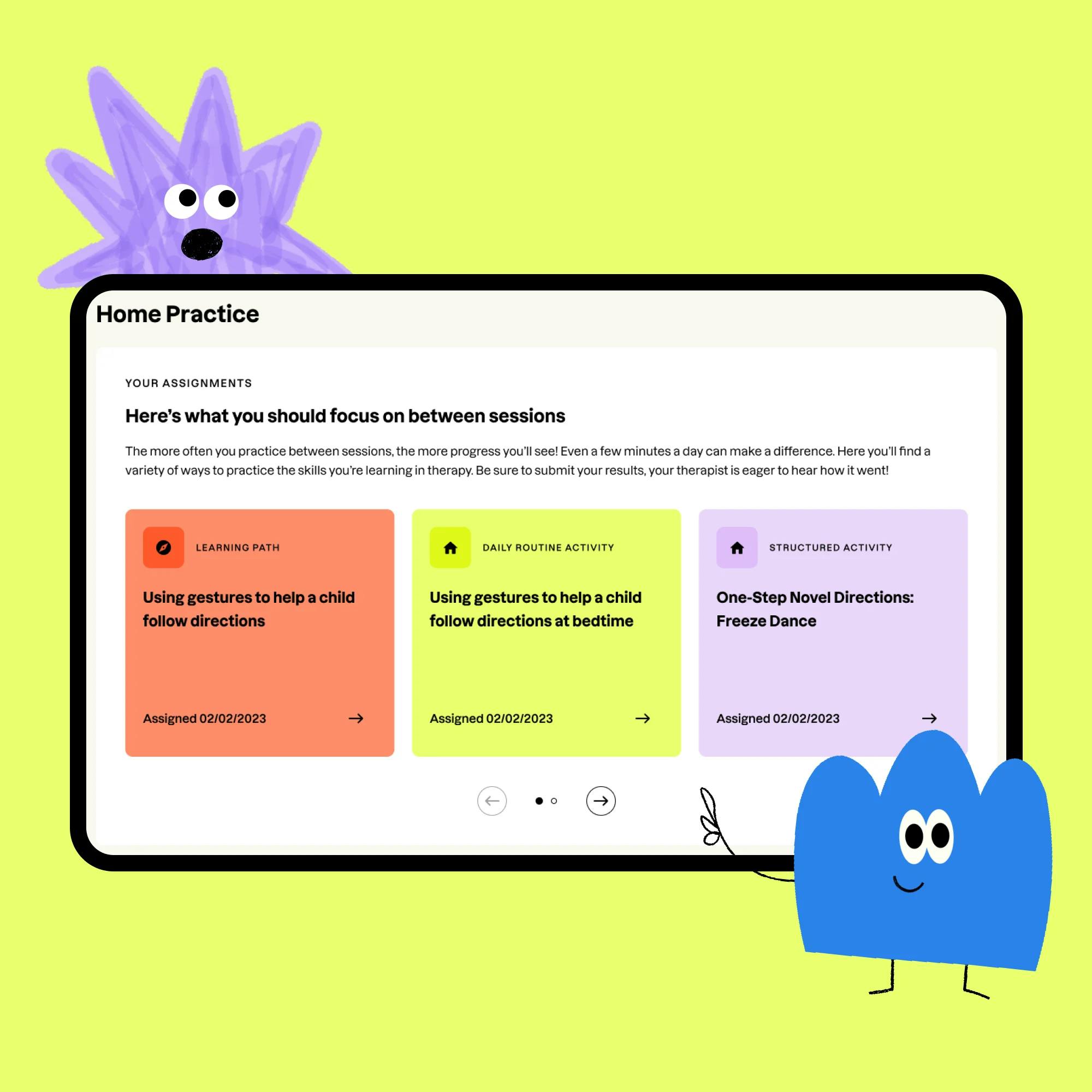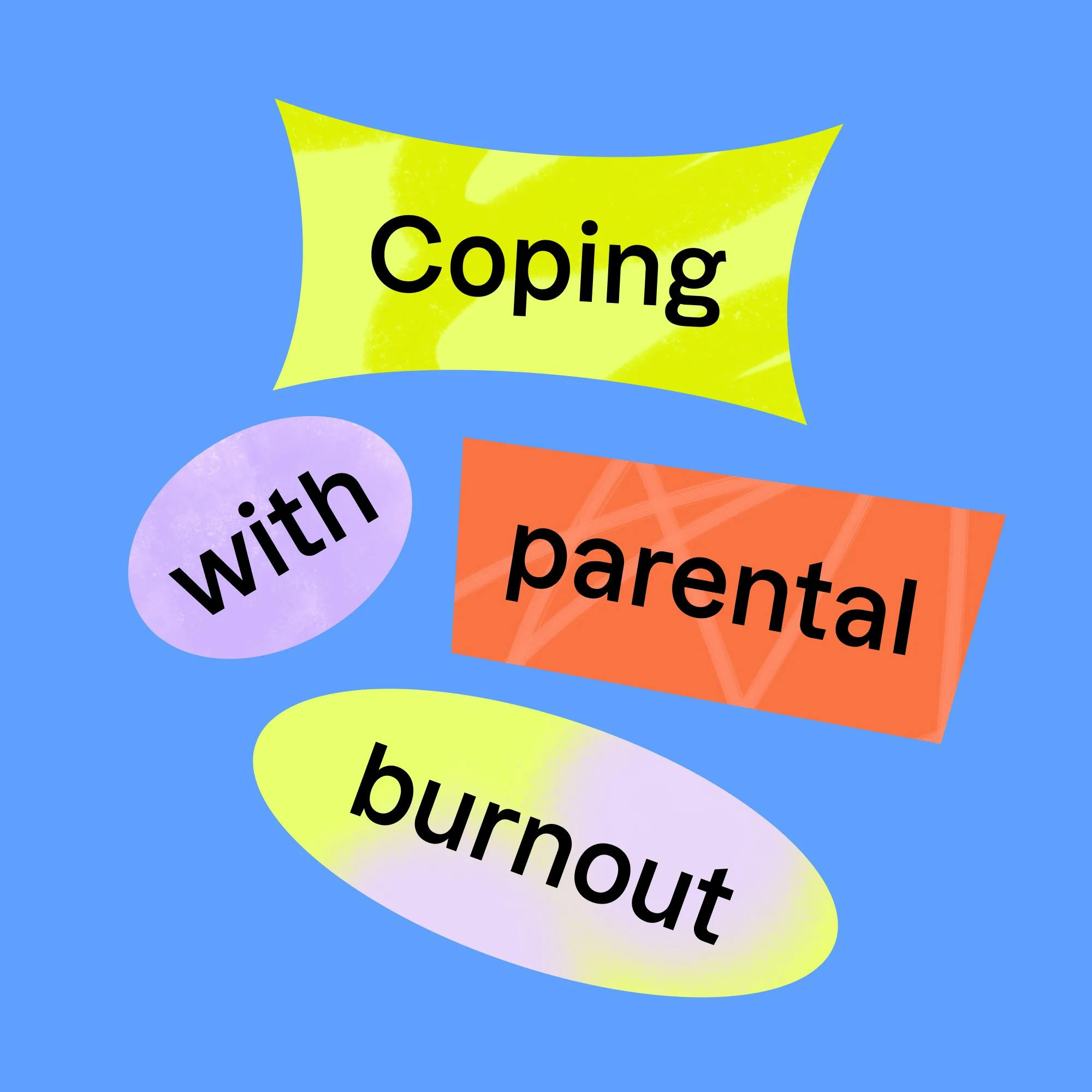Autism spectrum disorder (ASD) is a complex developmental condition. Autism can look different in different people, but it typically affects a person’s speech, language, and social skills.
Speech therapy is one of the most common therapies recommended for autistic people. At Expressable, our licensed speech therapists work with autistic children, teens, and adults to help them communicate more effectively. We created this guide to help you understand the signs of autism, how it can affect a person’s speech and language, how autism is diagnosed, and how speech therapy for autism works.
Free speech skills screener
Questions are tailored by age and cover all areas of communication. Take our 5-minute online screener and get instant feedback.
 Start the screener
Start the screenerWhat is autism?
Autism is a complex, lifelong diagnosis that commonly appears during the early years of childhood. Autism refers to a broad range of developmental conditions and behaviors that include challenges in speech and nonverbal communication, interpersonal relationships, and social interactions.
Like ADHD, dyslexia, and dyspraxia, autism is a form of neurodivergence. Neurodivergence refers to people whose brains work differently than what society considers “normal.” Neurodivergent people may have differences in communication, learning, social preferences, and behavior.
The phrase “on the spectrum” refers to a diagnosis of autism, which can have a wide range, or spectrum, of symptoms. Autism may be less severe, with only minimal impacts on a person’s life. Autism can also be a major developmental difference that requires significant support.
Autistic people often find it hard to have understandable conversations or express themselves through words, gestures, or facial expressions. They may have trouble picking up on social cues and understanding what people are thinking and feeling. Some autistic people are not verbal and use other methods to communicate.
Autistic people may also have very specific interests or repetitive behaviors. For example, they may focus on certain objects, like a toy or TV show, or resist any changes to their daily routines.


How common is autism?
According to the Centers for Disease Control and Prevention (CDC), about 1 in 31 children in the United States is autistic. Boys are 3.4 times more likely to be diagnosed with autism than girls. The overall prevalence of autism is lower among non-Hispanic White children than among Black, Hispanic, Asian or Pacific Islander, American Indian or Alaska Native, and multiracial children.
Perhaps most important, the CDC states: “Timely evaluation and identification of Autism Spectrum Disorder (ASD) among young children continue to be important public health goals because evidence links early treatment and services for ASD with improved outcomes.”
What causes autism?
There is no known cause of autism. This is related to the complexity of the disorder, as well as the fact that symptoms can vary dramatically. However, most researchers agree that certain genetic and environmental risk factors can increase a person’s likelihood of being diagnosed with autism.
Genetic links to autism
According to research, several different genes appear to be involved in autism. The presence of these genes can increase a child’s risk. Some genetic mutations may be inherited, while others can occur randomly.
If a parent carries one or more of these gene mutations, the child may inherit them, even if the parent does not have autism. Again, the majority of these gene changes do not cause autism by themselves, but they can increase the risk of developing the disorder.
Environmental links to autism
Researchers are continuing to explore whether pregnancy complications, air pollutants, lead poisoning, or other environmental factors play a role in triggering autism.
Other possible risk factors of autism
According to the Mayo Clinic, other factors may increase a child’s risk of developing autism. They include:
Gender: Boys are about 3 times more likely to develop autism than girls.
Family history: Families who have one child with autism appear to have an increased risk of having another child with the disorder. Parents or relatives of an autistic child may also have minor problems with social or communication skills.
Certain medical conditions: If your child has certain medical conditions, it can increase their chance of autism. Examples include fragile X syndrome (also called Martin-Bell syndrome), tuberous sclerosis, and Rett syndrome.
Parents' ages: There may be a connection between children born to older parents and autism.
Note: After extensive research, no research has shown a link between childhood vaccines and autism. This claim is unfounded and has no factual basis. In fact, the original study that started this debate has been debunked and retracted due to misrepresentation, poor study design, and questionable research methods.
What are the signs and symptoms of autism?
The signs and symptoms of autism generally appear in the early stage of childhood development, often before the age of 3 years old. As mentioned, these symptoms can vary from mild to severe. Sometimes they’re very easy to see. In other cases, autism symptoms may not be noticeable or recognized until your child is in school.
If you notice any developmental differences in your child, it’s important to talk with your healthcare provider or a speech therapist. Early intervention is one of the best ways to help an autistic child make progress and overcome their challenges.
According to the American Speech-Language-Hearing Association (ASHA), autism typically affects a person’s communication, social skills, and behaviors. Below we’ve listed some common symptoms in each area.
Signs of autism related to communication
Communication includes speaking, reading, writing, and understanding language. Signs of autism can include:
Delays in spoken language; may talk very little for their age or not at all
Inability to start or maintain a conversation
Difficulty communicating needs and desires
Difficulty understanding conversations and instructions; may respond to a question by repeating it rather than answering
Using challenging behaviors (like crying or temper tantrums) instead of words or gestures to communicate what they want
Challenges with learning to read and write; some autistic children may be able to read, but have difficulty understanding what they read (also called hyperlexia)
Repeating words or phrases they just heard or that they heard days or weeks earlier, called echolalia; some autistic children are gestalt language processors
Using a robotic speaking voice that lacks inflection or intonation
Sometimes it can be hard to tell the difference between autism and a speech delay. While speech delays are common in autistic children, a speech delay doesn’t automatically mean autism. Both an autistic child and a child with a speech delay may talk very little for their age, or not at all. They may both have trouble expressing their needs and wants, and use behaviors like tantrums to communicate. But there are some key differences with autism versus a speech delay. You can read more about them in this article.


Signs of autism related to social skills
An autistic person may have a hard time relating to other people. They may have trouble making friends and interacting with their peers, or they may show an overall lack of interest. It may be hard for an autistic person to:
Pick up on social cues and be socially aware
Understand how others are feeling
Share attention with someone else and focus on the same object or event
Develop peer relationships, which can include difficulty with sharing toys, taking turns, and making and keeping friends


Behavioral signs of autism
Autistic children may have a range of behavioral issues. These can include:
Restricted or repetitive patterns of behavior, which may include hand or body movements
Preferring not to be touched, held, or cuddled
Laughing, crying, or getting upset easily and for unknown reasons
Disliking certain sounds, smells, or textures (for example, may like very few foods or choose foods based on texture)
Becoming distressed by a change in daily routine
Being attached to certain objects, such as a toy or a TV character
Repeating unexpected behaviors, such as lining up their toys, rocking their head back and forth, spinning their body, or having trouble staying still

Early warning signs of autism in toddlers
In addition to the symptoms above, there are several early signs that a toddler may be autistic. Of course, many children without autism can show these signs and behaviors, too, but it’s often better to err on the side of caution. If you notice any of these signs of autism in your toddler, it’s important to talk with your child’s doctor and discuss an evaluation.
Signs of autism at age 1
Most infants are very social creatures. Even at this early age, it's possible to recognize signs of autism depending on how your baby or toddler interacts with the world around them. Signs of autism in a 1-year-old can include:
Not noticing or responding to a mother’s voice
Not recognizing their own name
Unable to look people in the eye
Lack of speech and language abilities, which at this age include babbling or pointing
Not smiling, laughing, or responding to social cues
Signs of autism at age 2
The signs of autism can be more apparent by a child’s second year. This is the age when children begin to really develop their language skills. Signs of autism in a 2-year-old can include:
Not pronouncing simple, single words by age 16 months
Unable to use simple, two-word phrases, like “Go up”
Loss of language skills they previously had
Lack of interest in the world around them; for example, not responding when a caregiver points out an object, like a large tree or plane flying overhead
How is autism diagnosed?
Diagnosing autism can be a process. Your healthcare provider will generally look at your child’s developmental history, as well as their communication and behavior, to make a diagnosis.
While autism can sometimes be diagnosed at 18 months or younger, by age 2 most professional diagnoses are reliable. However, some children don’t receive a diagnosis until they’re older, even into their teen or adult years.
There are several steps involved in an autism diagnosis. The CDC outlines each of these steps in detail. Ensuring that your child is properly monitored, screened, evaluated, and diagnosed is essential to getting them the care and services they need to live a fulfilling life.
Developmental monitoring for autism
There are typical developmental milestones that most children reach by certain ages. These cover how a child plays, learns, speaks, behaves, and moves. The CDC provides a checklist of milestones broken down by age.
Developmental monitoring means observing how your child grows and changes over time. If they are not meeting certain milestones, this is usually the first warning sign of autism. That’s why it’s important for parents, caregivers, and teachers to be involved in monitoring the child, as well as noting anything that seems atypical or uncharacteristic. You can then share these observations with your child’s doctor, which helps them evaluate your child and make a professional recommendation.
Personalized care for your child
We support autistic children for who they are and help them build new skills. Get matched with a licensed speech therapist today.
 Get started
Get startedDevelopmental screening for autism
Developmental screening is a more thorough way to formally assess your child for autism. However, a screening is not a diagnosis.
Screenings often involve a brief test or questionnaire about your child. These tools are based on research, and they include questions about your child’s language, movement, thinking, behavior, and emotions. While these tests are typically given by a doctor or nurse, they can also be done by other healthcare professionals.
Comprehensive developmental evaluation for autism
If your healthcare provider notices a problem or risk factor during the screening, a more formal evaluation may be needed. This is a comprehensive and in-depth evaluation of the child’s development. It is usually given by a pediatrician, child psychologist, speech-language pathologist, or other specialist.
The developmental evaluation may include a more thorough examination of your child, a test for your child to complete, and questionnaires for you to fill out. The results help determine whether the child may have autism and what kind of treatment is needed.
Pediatricians, pediatric neurologists, psychologists, or psychiatrists are typically the professionals who provide an official autism diagnosis.


How is autism treated?
There is no known cure for autism, and treatment isn’t one-size-fits-all. The goal of treatment is to support the person’s social, communication, and behavioral skills and improve their ability to function in their daily life.
As a parent, it’s normal to feel overwhelmed by all the therapies for autism. What your child needs now may change over time. That’s why it’s important to work closely with your healthcare provider, as well as any other specialists, such as a speech therapist. They’ll develop a care plan and strategy tailored to your child’s unique needs.
According to the Mayo Clinic, treatment options for autism include (but are not limited to):
Educational therapies: Autistic children like to maintain routines, and many prefer highly structured learning environments. Preschool children who receive intensive, individualized behavioral interventions have been shown to make good progress.
Behavioral therapies: Applied behavior analysis (ABA) can help children learn new behavioral skills and apply these skills in different situations through a reward-based system.
Family therapies: Caregivers and other family members benefit by learning ways to play and interact with their child. This coaching can also help them better manage behavioral problems and teach their child daily living skills.
Speech and language therapy: Speech therapists can address challenges with verbal, nonverbal, and social communication for autistic people (more information on this below).
Other therapies: Depending on your child’s needs, there are many other beneficial therapies. For example, occupational therapy focuses on teaching activities of daily living. Physical therapy can help improve your child’s movement.
Medications: No medication can cure autism, but certain medications may help control symptoms. Talk with your healthcare provider about any medications that may be helpful.


How does speech therapy for autism work?
Challenges with speech and language, like all autism symptoms, vary from person to person. Some autistic people may not be able to speak at all. Others may love to talk, but they have a hard time holding a conversation or understanding social cues like body language and facial expressions.
Speech-language pathologists, also known as speech therapists, play a key role in supporting autistic people. They can help autistic people of all ages become better communicators and improve both their verbal and nonverbal communication skills. This can help autistic individuals form relationships with others and function better in day-to-day life.
Your speech therapist will work with you to assess your child's communication strengths and challenges. They will develop a treatment plan that’s personalized to your child and family. You can learn more about speech and language evaluations for autism here.
Speech therapy for autism may focus on skills like the following:
Verbal communication: Speech therapists can help people articulate clearer speech sounds and words. This can help them express their thoughts and be understood by others.
Body language: Our body language is one of the most expressive parts of communication. It can signal whether someone is joking, serious, sad, or excited. Speech therapists can help autistic people understand what others are saying through their body language, match emotions with facial expressions, and recognize subtle physical signals.
Asking and answering questions: Understanding how to formulate and ask questions, as well as understand answers, helps us navigate through life. Speech therapists can help people develop these vital skills by recognizing and practicing the question-and-answer format.
Social pragmatics: Even if autistic people know how to say phrases like “good morning” and “thank you,” it can be tough to understand when, how, and to whom they should say it. Social pragmatics involve learning the time and place to use certain types of communication in social situations.
Prosody: This term refers to the melodic sound of a voice as it goes up and down in conversation. Many autistic people have flat prosody, which can often come off as emotionless. Speech therapists can help them build their vocal skills and modulate their tone of voice.
Conversation skills: Knowing how to make brief, simple statements is not the same thing as carrying on a back-and-forth conversation. Speech therapists work with autistic people to develop their conversation skills, exchange information naturally, and start a dialogue when unprompted.
Social skills: Speech therapists often help autistic people build social communication skills. This can include the ability to communicate, play, and interact with friends and family; stand at an appropriate distance when speaking with someone; pick up on social cues; and more.
Grammar: Some autistic people may refer to themselves in the third person or use incorrect tenses. Speech therapists can help address these grammar mistakes.


Will nonverbal autistic children ever speak?
Not all autistic children are nonverbal, but some are. Some children may be nonverbal for a short time and then begin to talk. Some may be nonverbal or minimally verbal for their whole life. Each autistic child is different.
Children who are nonspeaking need a way to communicate. There are many types of assistive devices and technologies that can help with this. These tools are called alternative and augmentative communication (AAC). Your speech therapist will let you know whether your child would benefit from AAC and teach you how to use it.
Examples of AAC methods for autism might include:
Sign language
Picture exchange communication system (PECS)
Communication apps on a tablet or iPad
Speech output devices (such as Dynavox)


Speech therapy for autistic teens and adults
Teens and adults may choose to receive speech therapy for autism that focused on skills such as the following:
Social skills: These are skills such as two-way conversation, staying on topic, knowing how and when to switch topics, and understanding other people’s viewpoints.
Understanding social cues: This might include understanding a person’s tone, picking up on sarcasm, etc.
Making friends: When conversations are challenging, it can be hard to make friends. Speech therapy can help autistic adults learn to build on their strengths and natural conversation style to help them better communicate.
Communicating via technology: Speech therapy can help people develop skills in texting, social media chatting, and direct messaging. Or the focus might be on communication at work.
Time management: A speech therapist can teach strategies to help a person manage their time, so they’re better prepared to handle work responsibilities and other real-life situations.
Problem solving: Speech therapy can also focus on problem-solving skills. Learning to think through the steps for solving a problem can be hugely helpful for autistic adults.


How Expressable treats speech and language disorders related to autism
Expressable matches families with a licensed speech therapist trained to evaluate and treat speech and language disorders related to autism. All therapy is delivered online via face-to-face video conferencing. Our therapists provide neurodiversity-affirming speech therapy. This means that we provide care to autistic and other neurodivergent people by accepting their differences, focusing on their strengths, and working to support them while building new skills.
Your child’s age and development will influence how your speech therapist interacts with them through these video chat capabilities:
Ages 0-3: Caregivers work directly with their child's speech therapist to learn cues and at-home strategies. This way they can confidently practice with their child outside the session and improve their child's communication. Learn more about the importance of parent involvement in an autistic child’s speech therapy in this article.
Ages 3-6: Caregivers attend video sessions alongside their child so they both learn valuable skills from their speech therapist. Reinforcing these lessons outside the session will continue to promote at-home skill building.
Ages 7 and up: Children can attend video sessions independently if possible, but caregivers are always kept in the loop with updates and tips during each session.
Autistic adults can attend sessions by themselves, but they are welcome to bring loved ones or family members as well. With online speech therapy, loved ones can attend from anywhere!
You can learn much more about Expressable's clinical approach to working with autistic people in our treatment guide.


Support beyond sessions: The Expressable portal
Your speech therapy doesn’t stop when the session ends. At Expressable, you and your loved ones will get access to our client portal, which makes practicing communication strategies easier and more effective. Here’s what you’ll find:
Learning Paths that explain and reinforce communication strategies
Demo videos that show real speech therapy techniques in action
Home practice activities you can do during your everyday routine
Text messaging support so you can ask questions, get reminders, or receive tips from your therapist between sessions.
By using the tools in the portal and practicing regularly, you can make faster progress and build more independence in your or your child’s communication.


Tips to support your autistic child
No one knows your child better than you. And as a caregiver, no one is better positioned to support your child at home and during activities of daily living. Below are some ways parents and caregivers can stay involved, advocate for their child, and provide a safe and nurturing environment to help them grow, learn, and thrive.
Be proactive
We’ve mentioned this before, but it’s worth repeating: If you suspect something is wrong, talk with your child’s doctor right away. Research has shown that earlier intervention leads to better outcomes. Early treatment can help reduce the challenges of autism over time.
Here are a few ways you can stay engaged and proactive in your child’s care:
Learn everything you can: The more you know about autism, the better prepared you’ll be to make informed decisions. Learn more about autism, talk openly with your healthcare providers, and be part of all treatment decisions.
Ask lots of questions: The only "dumb" questions are the ones you never ask! Don’t ever feel embarrassed. Ask as many questions as you want.
Find a team of trusted professionals: Treating autism often requires a team of professionals, including doctors, case managers, speech therapists, social workers, teachers, and more. Do your research and find a trusted care team that has your child’s best interests in mind.
Keep all of your records: Your child is going to have many visits, evaluations, and meetings with people involved in their care. Keep an organized file of paperwork to help you decide on treatment options and monitor progress.
Be an expert on your child: The more information you can give your healthcare provider and speech therapist about your child, the better treatment decisions they can make. What does your child enjoy? What do they find uncomfortable, calming, or frightening? What types of behaviors are they showing? How are they communicating or sharing their feelings?
Accept your child: Try not to compare your child to their peers. Instead, enjoy their quirks, celebrate their successes, and love and accept them unconditionally for who they are. You’ve entered a new and unfamiliar world, and this can feel scary and exhausting. But don’t give up. It’s impossible to predict the course of your child’s autism--they have a lifetime to grow and develop.


Provide a safe and structured environment
No one spends more time with your child than you. Making your home life safe, enjoyable, and tailored to your child’s needs will make it easier on everyone.
Stay on schedule: Whether at home or in the classroom, autistic children tend to prefer routines. Do your best to keep a structured schedule with regular times for meals, play, therapy, screen time, school, and bedtime.
Bring therapy home: Your child may be seeing several specialists or professionals. However, they often have a tough time applying what they learn in one setting to another. To create a consistent environment and support your child’s progress, stay in contact with their therapists and continue these techniques at home. For example, if your child is practicing certain speech sounds with their speech therapist, make flashcards with these same sounds to use at home.
Provide positive reinforcement: Praise and encouragement is extremely important for autistic children. Not only should you regularly praise them for developing or using a new skill, but make sure they understand why they’re being praised. If your child enjoys a certain type of food, toy, or activity, use these as ways to reward them.


Communicate verbally and nonverbally
Many autistic children have speech-related challenges. However, as your child works on these skills, there are other ways you can connect and bond with them.
Identify nonverbal cues: There are many ways your child is trying to communicate. You just have to remain aware and observant. For example, pay attention to the gestures they make when they’re tired, bored, or hungry. Look for particular sounds they make or facial expressions they use. You can also communicate with your child just by the tone of your voice, your movements, or your body language.
Pay attention to triggers: Many autistic children are hypersensitive to light, sound, touch, taste, or smell. Try to determine which triggers cause disruptive behaviors or positive responses. This can help you prevent situations that make your child uncomfortable.
Figure out your child’s motivation: Just like anyone, autistic children get frustrated when they feel misunderstood. This can cause them to act out. Throwing a temper tantrum is one way of communicating frustration--and it’s up to parents to try to understand what caused it.
Have fun together: Your child may be undergoing lots of therapy and education, but sometimes, they just need to be a kid. Make sure that playtime doesn’t get put on the backburner. Find out what makes them laugh and smile, and enjoy these activities together. Play is a central part of learning.


Make your own needs a priority
While you may spend a lot of time with your child, it’s important not to lose sight of your own needs. Raising an autistic child can require a lot of time, energy, and attention. It's easy to feel discouraged at times. However, for your own sake, you need to focus on your own health and wellbeing. Here are some ways to do that:
Support groups: Joining a support group, either in person or online, can help you meet families with similar circumstances. Caregivers in these groups often share information, provide tips, and mentor parents with newly diagnosed children.
Respite care: Never feel guilty taking a break. You deserve it! Respite care offers the chance to have a qualified caretaker take over your responsibilities for a short time, whether that’s for a few hours or a few days.
Counseling: If you’re feeling stress, anxiety, or depression, you may want to see a psychologist. That way you can talk about your experiences and feelings in a safe, accepting environment


Get matched with a speech therapist
If you’re looking for speech therapy for autism, reach out to Expressable today. We’ll match you with a licensed speech therapist who can perform an evaluation and help you determine the best next steps. Find the right speech therapist for you or your child here!
An important note: We believe that when speaking about any community as a whole, the best approach is to prioritize that community’s voices, needs, and preferences. Within the larger autism community, the current language preference is identity-first (e.g., "autistic child," rather than "child with autism"), which is why we use that language in our content. Expressable is committed to listening to and learning from the populations we serve. If and when their preferences change, we’ll adjust our approach accordingly.
How Expressable Can Help
Concerned your child isn't reaching age-expected milestones? Looking for communication support from a professional? Expressable is a national online speech therapy practice serving children and adults. We treat all major areas of communication and feeding, offer flexible hours including evenings and weekends, and accept most major health insurance plans. We’re proud to have earned more than 3,000 5-star reviews from our clients (4.9/5 average).
Our therapy model is centered on parent and caregiver involvement. Research proves that empowering caregivers to participate in their loved one’s therapy leads to better outcomes. That’s why we combine live, 1-on-1 speech therapy with personalized education and home practice activities for faster progress.
Communication is more than words. It’s how we share how we feel and show who we are. We’re here to help you or your child do just that.
 Abby Barnes, M.S., CCC-SLP
Abby Barnes, M.S., CCC-SLP









